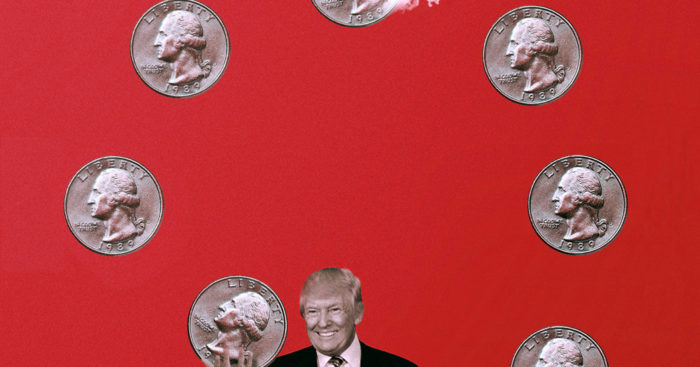
Advertisement
Opinion
Supported by
Want to Prevent a Recession, Mr. Trump? Stop Hurting the Economy
As the administration tries to keep growth going, its trade war weakens it.
By The Editorial Board
The editorial board represents the opinions of the board, its editor and the publisher. It is separate from the newsroom and the Op-Ed section.
Aug. 20, 2019ImageCreditCreditIllustration by Nicolas Ortega; photograph by Al Drago/The New York Times
Here’s some free advice for President Trump and his economic advisers, who are frantically searching for measures to ward off a recession: Look in the mirror.
The White House has reason to worry about the economic outlook. There are clear signs of weakness in recent economic data, and forecasters see an increasing chance that the American economy may stop growing for the first time in more than a decade.
The most obvious corrective is to abandon Mr. Trump’s erratic campaign to extract concessions from China and other major trading partners. While there is certainly room to improve the rules of global trade, the Trump administration hasn’t shown it’s up to the task. Lacking any apparent strategy for achieving its goals, it instead is engaged in a campaign of petty vandalism that has unsettled both American businesses and foreign allies.
Tariffs on Chinese imports have come primarily at the expense of American consumers, and Mr. Trump’s trade policies aren’t even helping the intended beneficiaries. He has repeatedly boasted of reviving the steel industry, declaring at a recent rally in Pennsylvania that American steel-making is again “thriving.” But one of the nation’s largest steel makers, U.S. Steel, said this month that it would suspend production at a Michigan plant and temporarily lay off up to 200 workers because of declining prices and demand.
The company’s stock price has lost 73 percent in value since Mr. Trump started trying to help in March 2018.
The best thing he could do to improve conditions, both at home and abroad, is to stop making things worse.
Instead, Mr. Trump and his aides are rummaging through the medicine chest of fiscal and monetary stimulants.
One idea under consideration is a temporary reduction in federal payroll taxation, a special income tax that provides funding for Social Security and Medicare. Cutting payroll taxes is a tried-and-true method of stimulating the economy, most recently employed by the Obama administration in 2011 and 2012. The government lets workers keep more of their paychecks, and consumer spending rises. But the cure is mismatched to the moment. Consumer spending has been strong this year; it is corporations that are sitting on their wallets.
Employing a general stimulus to address a specific economic weakness is also wasteful, and would leave the government with less ability to respond to future problems. Mr. Trump already has pushed through a large tax cut and a significant increase in spending. Annual federal deficits are soaring, and another tax cut would require further borrowing.
in STYLN_email_trump-0_control_STYLN_email_trump
Mr. Trump and his advisers have sought to play down reports about contingency planning. Presidents and their advisers often strike a confident tone about economic conditions, for the simple reason that a lack of confidence can be contagious. But Mr. Trump’s recent pronouncements are unlikely to shore up confidence. He has instead managed to sound panicked and Pollyannaish at the same time, as in a pair of tweets on Monday, the first of which declared the economy “very strong” and the second of which urged the Federal Reserve to revive the emergency measures it deployed in response to the 2008 financial crisis.
The state of the economy is neither that good, nor that bad.
Mr. Trump’s call for the Fed to cut rates by a full percentage point, and to resume buying Treasury bonds to drive down longer-term interest rates, amounts to a plea for the Fed to offset the consequences of his policies — and it lays the groundwork for blaming the Fed if the economy should dip into a recession. (He’s also suggested, baselessly, that Democrats and the news media are trying to cause a downturn.)
Business investment is weak because executives are concerned about the outlook for global growth — an outlook clouded in part by Mr. Trump’s campaign to disrupt trade.
Lower interest rates could encourage corporate borrowing. But when the Fed reduced its benchmark interest rate by a quarter of a percentage point in July, Mr. Trump immediately announced a new round of tariffs on Chinese imports.
In effect, he used the cover provided by the Fed’s decision to inflict more economic damage.
Presidents generally receive more credit than they deserve for economic growth, and more blame than they deserve for downturns. In truth, most presidents exert relatively modest influence over the near-term performance of the American economy. But Mr. Trump is proving himself to be an exception. He may yet show that a determined president can drive the American economy into a recession.
Related More on President Trump and the economy.Trump Administration Considers Moves to Bolster EconomyAug. 19, 2019How the Recession of 2020 Could HappenAug. 17, 2019Opinion | The Editorial Board: President Trump’s Fruitless Trade WarAug. 6, 2019
The Times is committed to publishing a diversity of letters to the editor. We’d like to hear what you think about this or any of our articles. Here are some tips. And here’s our email: [email protected].
Follow The New York Times Opinion section on Facebook, Twitter (@NYTopinion) and Instagram.
A version of this article appears in print on , Section A, Page 24 of the New York edition with the headline: Mr. Trump, Stop Inviting a Recession. Order Reprints | Today’s Paper | Subscribe
Advertisement
